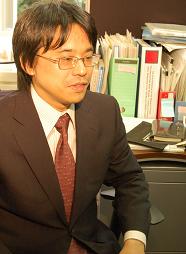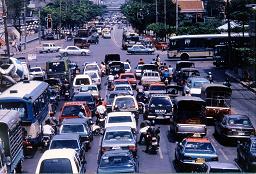How Thailand Managed to Overcome Two Crises: With "Financial Restructuring," "Foreign Capital Dependence," and "Promotion of Exports"
2011.01.04

Thailand’s economy has recently recovered from the two financial crises of the 1997 Asian Financial Crisis and the 2008 “Lehman Shock,” and in 2010 is now growing steadily at nearly 8%. JICA-RI is currently conducting a research project that analyzes Thailand’s recovery process to see the implications for sustained economic development in Asia. In this interview, JICA-RI research fellow Yasunobu Okabe discussed a field survey in Bangkok (which took place from November to December, 2010) about recovery factors and the potential challenges of Thailand’s economy.
The Slow Pace of Private Sector-driven Financial Restructuring
-Thailand had achieved rapid economic growth, to the extent it was dubbed the East Asia Miracle, but starting in the late 90s, it was hit with two financial crises, only to recover once again. What led to its recovery?
I believe that there were two major factors. The first was the financial restructuring process that promoted the disposal of NPLs and strengthened banks. The other is the foreign firm-dependent, export-driven strategy adopted by the Thai government.
-What kinds of financial restructuring measures did the Thai government carry out?
It realigned the banking sector by first closing down 56 financial firms, and then urged commercial banks to dispose of their nonperforming-loans (NPLs) and increase their capital bases. For small- to medium-sized banks, it promoted nationalization and mergers with foreign banks. In 2001, four years after the 1997 crisis, a public asset management corporation was also established to accelerate the disposition of bad assets. These interventions proved to be effective. They decreased the NPL ratio from the post-crisis level of 40% down to 5.7 % by 2008. The capital adequacy ratio also bounced back to 13.8%. With the strengthening of banks, the volume of loans recovered to the pre-crisis level of 2005, consequently easing the burden on debtor companies.
-How was Thailand’s financial restructuring process compared to that of South Korea’s? Korea’s economy also suffered a major blow from the 1997 financial crisis, but has been regaining strength ever since.
Due to differences in their approaches to financial restructuring, Thailand’s restructuring process was much slower than Korea’s. Korea adopted a government-driven approach, with the government playing an active role in promoting the disposition of NPLs and strengthening capital bases. But the Thai government took a more private sector-driven approach; in essence, calling for private banks to voluntarily implement these measures. Behind this approach are historical factors, such as traditional sentiments that do not welcome government intervention in the financial market, or the banking sector’s continued oligopoly. We can’t just say that Thailand should have adopted a government-led approach – that’s a sweeping generalization. Yet it is safe to say that, even though financial restructuring played a major role in the economic recovery, the main cause of its delay was this private sector-driven approach.”
Can Foreign Firm-Dependency Prevent the “Middle-Income Trap”?
-How did the slow financial restructuring process affect Thailand’s economic recovery?
Naturally, commercial banks carrying considerable NPLs were cautious, and reluctant to lend money. We should note that the ratio of loans to manufacturers, who are the driving force of Thailand’s economy, had gradually decreased, dropping to about 20% by 2009. In contrast, the ratio of loans for personal consumption had increased to over 20%. This suggests that commercial banks only played a limited role in the recovery of the manufacturing industry.”

Photo by JICA
-But the manufacturing industry did bounce back, and contributed greatly to the recovery of the economy. Do you believe that there is a strong potential in Thailand’s manufacturing industry?
The manufacturing industry, represented by automobiles, computers, and related parts, is certainly the core of Thailand’s export sector. It is the engine that drives Thailand’s economy. But the reality is not that simple. As a result of welcoming many foreign companies and promoting economic strategies that depend on foreign capital, the majority of firms in the manufacturing industry now are not domestically owned but foreign (Japanese, for example). This has become a worry for the last few years.
-Does this mean that further economic growth cannot be expected while Thailand still remains dependent on foreign capital?
The World Bank calls this the ‘middle-income trap,’ meaning strong economic growth can’t be maintained solely by the accumulation of production factors like labor and capital. This suggests that unless Thailand escapes from this trap, it can’t break away from its current middle-income status and catch up to the level of other countries like South Korea and Taiwan. For Thailand to join the high-income group, it is crucial to produce value-added products through technological innovation and productivity improvement — or in other words, an upgrade of the entire economy is necessary. There is a growing debate on the limitations of economic upgrade in countries that remain dependent on foreign capital. Many experts also believe that helping domestic companies grow is a pressing issue in Thailand.”
The Bottleneck of Low Government Capacity
-The export-led growth strategy would leave the economy deeply dependent on foreign markets. Is this a potential concern?
Excessive dependence on foreign markets will make the economy vulnerable to the direct impacts of worldwide recessions. Because of this, there has been a debate within the Thai government to boost domestic demand. An official from Thailand’s central bank was quoted just recently in an article, saying that the country’s export-dependent economic strategy should be revised and switched to a domestic demand-driven approach.
But in reality, there is a deep-rooted perception that a domestic demand-driven approach would be difficult. This is because in order to expand domestic demand, wages must be increased to boost people’s buying power, but this would in turn lead to exported goods costing more.
-Which direction is Thailand’s economy headed for: expansion of domestic demand, or dependency on exports?
During our field survey, many economists told us that the foreign capital-dependent, export-driven strategy can still be effective for the time being. They are aware that despite the low prominence of domestic companies, both economic growth and economic upgrade are progressing simultaneously. One example is Nissan Motors, which has started to manufacture eco-friendly cars in Thailand and is re-importing them to Japan. Other Japanese automakers are expected to follow suit. The concentration of automobile industries in Thailand makes such schemes possible. So, basically, the general assumption is that industrial upgrades can proceed even when the manufacturing industries are not based on local capital.
-What about efforts to boost competitive domestic firms? Is there any progress, and if not, then why not?
In the automobile industry, for example, there is one high-performing domestic parts manufacturer, Thai Summit. But that is the exception. Most domestic firms have not yet developed to become assembly or parts manufacturing companies. An important factor in encouraging the growth of firms is government capacity — the ability to formulate appropriate industrial policies. More specifically, it is the capacity of government offices dealing with economic matters to do things like to share goals and interests with private companies, to heighten the credibility of their policies and actions, and to monitor economic behavior. However, since Thailand still lacks this sort of government capacity, the development of domestic companies remains a difficult task.

-Please tell us about your future research directions.
What I’ve discussed here today is just one aspect of Thailand’s economic recovery process. But I should be able to get a clearer picture of how various Asian countries managed to recover from financial crises through a careful analysis of the individual facts. I also believe that further research will help us examine the political and economical conditions that support the recovery of Asian economies, as well as JICA’s role in assisting these processes.
Related Research Area: Growth and Poverty Reduction
Related Research Project: Economic Development in Asia: The Second East Asian Miracle? Political Economy of the Rapid Recovery from the 1997 Crisis

事業事前評価表(地球規模課題対応国際科学技術協力(SATREPS)).国際協力機構 地球環境部 . 防災第一チーム. 1.案件名.国 名: フィリピン共和国.

事業事前評価表(地球規模課題対応国際科学技術協力(SATREPS)).国際協力機構 地球環境部 . 防災第一チーム. 1.案件名.国 名: フィリピン共和国.

事業事前評価表(地球規模課題対応国際科学技術協力(SATREPS)).国際協力機構 地球環境部 . 防災第一チーム. 1.案件名.国 名: フィリピン共和国.

事業事前評価表(地球規模課題対応国際科学技術協力(SATREPS)).国際協力機構 地球環境部 . 防災第一チーム. 1.案件名.国 名: フィリピン共和国.

事業事前評価表(地球規模課題対応国際科学技術協力(SATREPS)).国際協力機構 地球環境部 . 防災第一チーム. 1.案件名.国 名: フィリピン共和国.
scroll